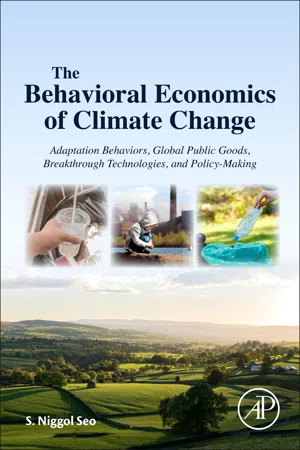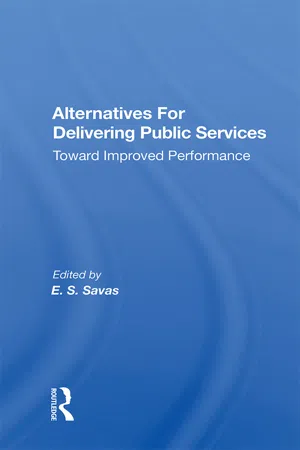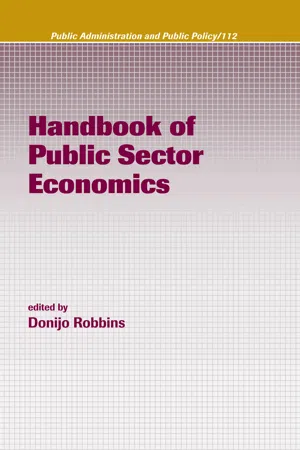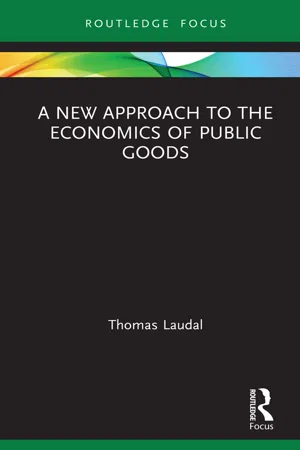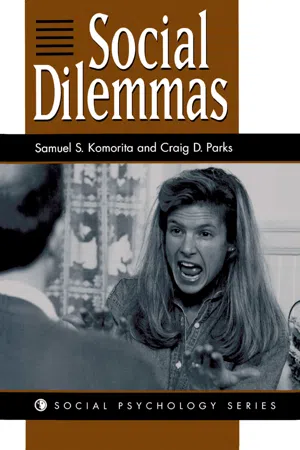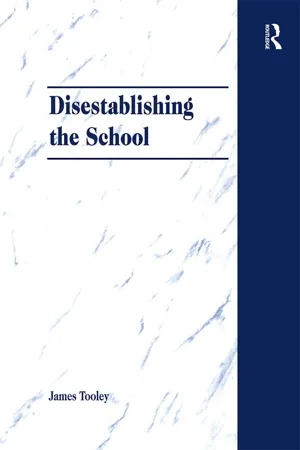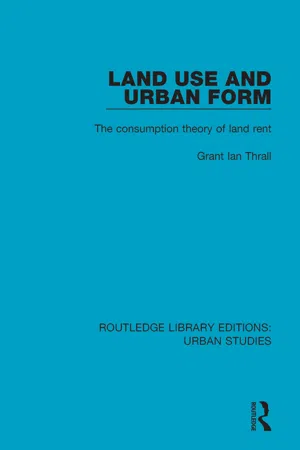Economics
Public Goods
Public goods are goods or services that are non-excludable and non-rivalrous, meaning that individuals cannot be excluded from their use and one person's consumption does not diminish the availability for others. Examples include national defense, public parks, and street lighting. Because of their characteristics, public goods are often provided by the government to ensure their availability to all members of society.
Written by Perlego with AI-assistance
Related key terms
9 Key excerpts on "Public Goods"
- eBook - ePub
The Behavioral Economics of Climate Change
Adaptation Behaviors, Global Public Goods, Breakthrough Technologies, and Policy-Making
- S. Niggol Seo(Author)
- 2017(Publication Date)
- Academic Press(Publisher)
Seo, 2012 ). Furthermore, nonexistence of a global government means that any agreement reached after hard-fought negotiations may not be enforceable.In this chapter, the present author will provide a comprehensive review of the theory of Public Goods, global Public Goods, and their efficient provisions. Being intended as a textbook for upper undergraduate and graduate courses on economics, this chapter will also provide mathematical formulations of the problems and solution mechanisms with regard to Public Goods and global Public Goods wherever possible (Baumol and Oates, 1988 ; Mas-Colell et al., 1995 ). The chapter will focus on a variety of environmental problems, e.g., air, water, mobile pollution problems, and policy experiences with them in the past many decades in the contexts of Public Goods and global Public Goods (Tietenberg and Lewis, 2014 ).2. Defining Characteristics of a Public Good
A public good is an abbreviated terminology for a public consumption good. A public consumption good is defined in contrast to a private consumption good, which is called in short a private good (Samuelson, 1954 ). A public good has a feature of “publicness” in its consumption. Before Samuelson, authors referred to the term “social goods” (Bowen, 1943 ; Musgrave, 1959 ).A public good is defined by two prominent features in its consumption: nonrivalrous and nonexcludable. A public good has the property of nonrivalry in that consumption of a public good by an individual does not decrease the supply available for other individuals. As Paul Samuelson first described it, goods “which all enjoy in common in the sense that each individual's consumption of such a good leads to no subtractions from any other individual's consumption of that good…” are goods with nonrivalry (Samuelson, 1954 - eBook - ePub
Alternatives For Delivering Public Services
Toward Improved Performance
- Emanuel S. Savas(Author)
- 2019(Publication Date)
- Routledge(Publisher)
1 Public Goods and Public ChoicesVincent Ostrom and Elinor Ostrom Workshop in Political Theory and Policy Analysis, Indiana UniversitySummary
A new mode of analysis for dealing with the organization and delivery of Public Goods and services has developed over the last two decades. This mode of analysis, identified with public choice theory, involves the application of economic reasoning to nonmarket decisionmaking. A key element in the analysis turns upon the nature of goods and services. Characteristics which pertain to exclusion and jointness of use can be arrayed to define different types of goods and services. A public good is defined as one which is not subject to exclusion and is subject to jointness in its consumption or use.Characteristics of nonexclusion and jointness of consumption or use, create situations in which market arrangements may fail to meet individual demands for Public Goods. Special forms of governmental or quasi-governmental organization are required to deal with these contingencies. The problems, however, occur largely in relation to the organization of collective consumption. As long as appropriate collective consumption units are organized, several alternative options can be used for the production and delivery of Public Goods and services. These options include private suppliers as well as governmental agencies serving as suppliers.Where collective consumption is organized apart from production in a public economy, market-like arrangements can exist among producers and collective consumption units. Relations among such units can be conceptualized as forming public service industries in which multiple units coordinate their efforts to supply a particular type of good or service to a community of users. Where competitive pressures are maintained and effective mechanisms for conflict resolution are available, public choice theory suggests that public service industries characterized by multiplicity and overlap, will be more efficient and responsive to user demands than highly integrated governmental monopolies. Public economies that are open to competitive supply of public services by private enterprises are likely to be more efficient than public economies which foreclose such competitive opportunities. - eBook - ePub
- Donijo Robbins(Author)
- 2017(Publication Date)
- Routledge(Publisher)
head tax is a uniform tax, where the same amount is required from all individuals. The disadvantage of such taxes that are not contingent on behavior is that they are regressive because they consume a bigger percentage of the income of the poor. Theoretically, the person with fewer dollars will value each of them more highly, so the head tax causes a great reduction in the utility of the poorest individuals. The few dollars saved by charging all individuals the same amount means less to the wealthy. Thus a regressive tax would reduce the utility of the poor to such a great extent that total utility is diminished. Therefore, while the provision of pure Public Goods through tax revenue is most efficient, the process of collecting the taxes may introduce its own inefficiencies.5.5 Conclusion
Public Goods are both nonrival in consumption and nonexcludable. Perhaps the purest example of a public good is national defense. Once Public Goods are provided for one person, they are available for all, and it is difficult, if not impossible, to exclude people who do not contribute from enjoying the good. Nonrivalry and nonexcludability create major difficulties to attempts to provide Public Goods through voluntary market transactions. People face the temptation to be free riders and enjoy the goods paid for by others. Therefore almost all societies, even market economies, opt for public provision of Public Goods through tax revenue.References
- Anderson J.E. Public Finance: Principles and Policy. Boston: Houghton Mifflin, 2003.
- Bruce N. Public Finance and the American Economy , 2nd ed. Boston: Addison Wesley, 2001.
- Buchanan J.M. Public Finance in Democratic Process: Fiscal Institutions and Individual Choice. Chapel Hill, NC: University of North Carolina Press, 1967.
- Buchanan J.M. The Public Finances , 3rd ed. Homewood, IL: Irwin, 1970.
- Buchanan J.M. The Demand and Supply of Public Goods. Indianapolis: Liberty Fund, 1999.
- Downs A. Inside Bureaucracy. Glenville, IL: Scott Foresman, 1967.
- Due J.F., Friedlaender A.F. Government Finance: Economics of the Public Sector , 5th ed. Homewood IL: Irwin, 1973.
- Gwartney J.D., Stroup R.L. Economics: Public and Private Choice , 8th ed. Fort Worth, TX: Dryden, 1997.
- Heikkila E.J. The Economics of Planning. New Brunswick, NJ: Center for Urban Policy Research, 2000.
- Holcombe R.G. Public Finance: Government Revenues and Expenditures in the United States Economy. St. Paul, MN: West, 1996.
- Hume D. A Treatise on Human Nature
- eBook - ePub
- Thomas Laudal(Author)
- 2019(Publication Date)
- Routledge(Publisher)
need as proposed by Light (2000). This means that Public Goods are defined by the subjective perception of those using/consuming the goods and will vary between cultures, societies, and different economic welfare levels. A variant of this is merit goods. These goods should benefit the users/consumers even in situations where they are not in demand by the targeted customer/consumer group. Musgrave and Musgrave (1973) characterized the incentives or subsidies promoting such kind of goods to the less affluent as an expression of paternalism. The aim is to correct the market in situations where users/consumers lack relevant information. In the present text the need, or merit, is not referred to as a defining characteristic of a public good.The basic concepts describing Public Goods“Goods” : Refers to anything that is in demand by humansIn a wider understanding, “a good” is defined as anything that is good, or something that has economic utility, or satisfies an economic want (Webster dictionary). We refer to “users/consumers” in contexts where the public good may be a commodity, service, or something consumable.1)“Shared goods” : A good where there is joint and uninhibited accessA “shared good” is shared in two ways: First, the nature of the good demands that the good is shared among those demanding the good. There is an uninhibited access to the good and it is not possible for companies to appropriate the full benefits arising from their production or distribution of the good. Second; it must also be shared in order to be fully utilized : To benefit from the good it must be utilized by a group. “Shared” is associated with something owned, divided, felt, or experienced by more than one person (Cambridge.org ), or as something we have in common, or held or experienced in common (thefreedictionary.com - eBook - ePub
- Antonio Merlo(Author)
- 2018(Publication Date)
- Routledge(Publisher)
So note we are talking here about the provision of Public Goods and not their production. The key political decision is how much money to allocate toward the provision of Public Goods, regardless of whether their production is done by private firms or by government-owned or government-controlled enterprises. For the purpose of this chapter, we will focus on how many fighter jets to buy, how many miles of highways to build or repair, how much money to invest in flood prevention and not so much on who builds the jets or is the asphalt and concrete paving contractor. It is also important to be clear about the definition of Public Goods we will be using here. All goods and services in a political economy can be classified according to two basic characteristics: rivalry and excludability. Rivalry: Rivalry means only one person can consume the good at a time. A good that is non-rival in consumption is a good that more than one person can enjoy consuming simultaneously, like a park bench: more than one person can sit there at once. A candy bar, on the other hand, is rival in consumption: only one person can be eating a Snickers at any time. Excludability: Excludability means there is a technology such that we can exclude someone from consuming the good if we want to. There is no such technology for clean air. Hence, clean air is non-excludable. There is, however, a technology to exclude people from using a road unless they pay. Hence, a toll road is excludable. It is important to note that whether the technology is actually used is not the matter at hand, it is whether restricting access to a good or service is technologically possible. Also, the classification as an excludable good is not an absolute, but it depends on the state of technology - eBook - ePub
- Samuel S Komorita(Author)
- 2019(Publication Date)
- Routledge(Publisher)
A public good is a product or service that can be “consumed” by members of a group, and its provision is almost entirely dependent on contributions by group members. A public good is distinguished from other types of consumer goods by two properties. First, the good has jointness of supply ; it cannot be “used up” no matter how many group members consume it. Thus, your public television station will not “run out” of programming, even if everyone in the entire city tunes in at the exact same time. Second, a public good has impossibility of exclusion. This means that it is almost impossible to restrict noncontributors from consuming the good. Even if your public television station were able to find out that you were a noncontributing viewer, there is almost nothing they could do to restrict your regular consumption of their programs. Recall that the defining characteristic of a social dilemma is the conflict between individual and collective rationality. The principles of jointness of supply and impossibility of exclusion make it clear what the individually rational choice concerning Public Goods is: since your consumption of the good will not affect the amounts that other members can consume (jointness of supply), and since you cannot be prohibited from consumption (impossibility of exclusion), the individually rational thing for you to do is to not contribute to the good’s provision. This is illustrated in Table 3.1. Regardless of whether the station gets enough donations to continue broadcasting, your personal outcome is greater if you do not give any money - eBook - ePub
Disestablishing the School
De-Bunking Justifications for State Intervention in Education
- James Tooley(Author)
- 2017(Publication Date)
- Routledge(Publisher)
For education in both is still publicly funded through taxation, publicly provided, and publicly regulated. However, this prima facie case does not hold, for, as we shall see, if education is a public good this could have implications for the particular sort of regulations, funds and provision required of the state. In any case, we are concerned in this book with the applicability of the arguments to a more ‘genuine’ market, West’s market model, and hence Grace’s objections, if they hold, will here be on very strong grounds indeed. Now, economists define a public good as satisfying up to three conditions: (i) indivisibility, (ii) nonrivalness and (iii) nonexcludability. Indivisibility pertains to a good, any given unit of which ‘can be made available to every member of the public’ (Taylor 1987 p. 5); for example: a bridge over a river, which can be used by anyone without extra costs being incurred. Nonrivalness is virtually the same as this, accept that it is the benefits available to eveiy member of the public which are not reduced, rather than the amount of the good. A good which is indivisible, then, need not be nonrival, nor vice versa. For example, the ‘good’ of hiking in the Grand Canyon could be, to a large extent, indivisible, in that many millions of people could do it without thereby hindering others. However, the more people who hike, the lower the enjoyment of those who wished to be in an empty wilderness, so, in this case, the indivisible good is not nonrival. Finally, nonexcludability pertains when it is not feasible to exclude any individual members of the group from consuming the good. The classic economic example is of the lighthouse: ‘Each shipping company owner knows that if another shipping company erects a lighthouse it will effectively serve his ships as well.’ (Cowen 1992 p - eBook - ePub
The Economics of Law, Order, and Action
The Logic of Public Goods
- Jakub Bozydar Wisniewski(Author)
- 2018(Publication Date)
- Routledge(Publisher)
An Austrian critique of the theory of Public Goods2.1 Introduction
Perhaps the most common argument describing a putatively beneficial function performed by a monopoly of force refers to its alleged ability to supply society with certain crucial, otherwise unattainable classes of goods. There are many names to designate such goods and many ways to categorize them, but for my purposes I shall regard them as falling into two relatively broad classes: club and common goods, which together constitute the category of Public Goods.Various theorists writing on the subject in question identify the said goods according to various characteristics. Malkin and Wildavsky (1991) provide an illuminating insight into the degree to which there is no final agreement on the matter. Although in general the literature on Public Goods is “terminologically over-endowed” (Hummel 1990, p. 90), which engenders a great deal of semantic confusion, I believe that it is fair to say that since the publication of Samuelson’s classic articles on the subject (Samuelson 1954, 1955), one strand of terminological convention has come to dominate the picture. According to this convention, club goods are defined as possessing the characteristic of joint (or non-rival) consumption (Buchanan 1965; Olson 1971; Berglas 1976; McNutt 1999), whereas common goods are defined as possessing the characteristic of non-excludability (or the existence of related externalities) (Musgrave and Musgrave 1980; Kim and Walker 1984; Ostrom 1990).The former means that the consumption of a unit of a given good by a particular person does not in any way diminish the ability of others to consume that same unit, whereas the latter means that a given good produces spillover effects, which enable non-payers (most notably the so-called “free riders”) to benefit from the good without in any way contributing to its production. Some standard examples of the former type of goods – that is, pure club goods (non-rival but excludable) – would be TV signals and computer software. Some examples of the latter type – that is, pure common goods (rival but non-excludable) – would be air and fish in the ocean. Finally, some paradigmatic examples of the goods combining the previous features, oftentimes called pure public (Leach 2003, pp. 171–86) or collective (Demsetz 1970) goods, include lighthouses and national defense. - eBook - ePub
Land Use and Urban Form
The Consumption Theory of Land Rent
- Grant Ian Thrall(Author)
- 2017(Publication Date)
- Routledge(Publisher)
13 Public Goods and externalities 13.1 Introduction The institutional framework within which people live and urban change occurs was demonstrated in Chapter 12 to be a force in the evolving city geography. This chapter continues with the discussion concerning the public sector. Here, in contrast to government institutions, the focus is upon goods and services provided by the government. The same analysis can be used to explain the effect that the general environment has upon the geography of the city. The general environment can include a seascape view; can include a source of noxious emissions such as a chemical dump or waste-disposal site; and can include proximity of households to other households, at least one of which group is prejudiced against the other. The geography of the city is determined in part by the mix and scope of such Public Goods. The densities of environmental attributes or local Public Goods may be uniformly distributed within the urban area; such local Public Goods or environmental attributes G are within the tradition of the pure public good. They possess nonrivalry and nonexcludability in consumption; the densities of environmental attributes or local Public Goods may at some locations be greater than at other locations, and such local Public Goods or environmental attributes can be referred to as externalities : Definition 13.1 An externality is a nonpriced good distributed over space. The direct effect of a positive externality can increase household welfare, while a negative externality can decrease household welfare
Learn about this page
Index pages curate the most relevant extracts from our library of academic textbooks. They’ve been created using an in-house natural language model (NLM), each adding context and meaning to key research topics.
